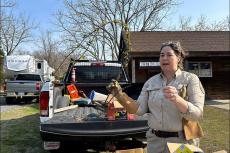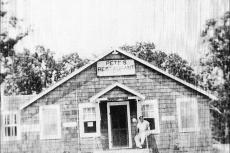The East Hampton Historical Society broke ground on a climate-controlled collections-storage center at the Mulford Farm last Thursday. It will unite the historical society’s 20,000 archival items — now stored at five separate sites — under one roof.
Aside from the climate controls, the 5,700-square-foot, two-story facility will have fire-suppression systems, pest management, and relative humidity settings, according to Anna Muller, the society’s curator of collections, who frequently works with the archival materials that will be stored in the new building.
“In addition to being the repository for our community’s material culture, the East Hampton Historical Society contains objects that any museum in America would be absolutely crazed to get their hands on,” Steve Long, its executive director, said at the groundbreaking.
Some 40 years ago, Mr. Long said, Christopher Belson, a former director of the society, had an idea for a climate-controlled building. Now, the organization is “finally achieving his vision and building a state-of-the-art home that our collections deserve,” he said to the several dozen people in attendance.
State Senator Anthony Palumbo and Assemblyman Fred W. Thiele Jr. attended the groundbreaking, having previously helped secure the funding through a grant from the New York State Council on the Arts.
“After being in the New York State Assembly for 30 years, I’m about to be put into storage myself, so I’m all for this project,” Mr. Thiele joked about his retirement next month. “And the climate control, very nice. I appreciate that.”
When he first heard of the society’s Campaign for Collections Stewardship, which raised money for the collections center, Mr. Thiele again joked that he recoiled at the thought of another campaign.
“This is a campaign of a much different type for a very, very good cause, and one that we can all agree upon on a bipartisan basis,” he said. “The East Hampton Historical Society has done such an outstanding job in preserving our heritage.”
The Council on the Arts has been awarding these capital grants for fewer than 10 years, he continued, adding that he is “glad to see some of this money coming back home.”
“It’s great work on your end to secure this grant to help out,” Mr. Palumbo said. “It’s a bit of a ‘Hunger Games’ when you go around the state, so we all kind of fight for these things to ultimately have it happen in our communities.”
The project will most directly affect the job of Ms. Muller, the collections curator, who welcomes the change. “It will serve the purpose of bringing our entire collection under one roof, which is a major concern for us, since our collection resides wherever there is space right now at our five different locations,” she said.
Over the summer, she cleared out the current storage barn, which was built in 1976 — “moving things around like Jenga” — in anticipation of the new facility at the James Lane farm.
“We’ve been collecting objects for over a hundred years, so that stuff really adds up,” Ms. Muller said, referring to the historical society’s founding in 1921. “Over the years, things got put in closets, things got put in attics.” Recently, though, much of it has been rediscovered.
It’s “very common,” she said, for smaller historical societies to lack a full inventory of their collections, as is the case here. However, moving the collections for the new facility has offered a rare opportunity to account for the full catalog.
“Part of the issue with having a collection that’s been gathered for over a hundred years is that the record keeping is very varied,” she said. “So, there’s either spotty record keeping, no record keeping, the methodologies change — decades, decades — so part of my job is trying to track down these objects.”
Ms. Muller finds “interesting things all the time,” and this only accelerated over the summer, when she inventoried the archives ahead of the groundbreaking ceremony. Recently, for instance, she found a 19th-century microscope in “impeccable condition” with custom wooden cases containing the slides.
While awaiting construction, the historical society is temporarily storing its collections in an art storage facility.
Mr. Long said he wants to see the new facility outfitted with compact mobile storage equipment. In addition to providing more storage space, the building will also provide “critical space” to expand the collections in the future.




